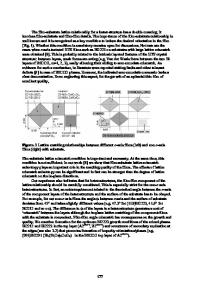Thin Film Ruthenium Oxide - Iridium Oxide Thermocouples
- PDF / 328,202 Bytes
- 8 Pages / 420.48 x 639 pts Page_size
- 65 Downloads / 353 Views
THIN FILM RUTHENIUM OXIDE - IRIDIUM OXIDE THERMOCOUPLES
KENNETH G. KREIDER National Institute of Standards and Technology,
Gaithersburg, MD
20899
ABSTRACT Ruthenium
oxide and iridium oxide have outstanding resistance
to
corrosion.
These oxides are also excellent electrical conductors and have
been used
as
electrical
biochemical
and
charge
electrochemical
injection properties
electrodes. have
consideration as high temperature pH electrodes. useful form for these applications
also
Their led
unique
to
their
Thin films are the most
as they permit the miniaturization of
fast response sensors and electrodes. This study was used to characterize the thermoelectric and electrical conductance parameters of ruthenium and iridium oxide sputtered thin films. The electric and thermoelectric properties of the thin films were found to be sensitive to the annealing temperature of the sputtered oxides. properties of the film are related to the microstructure, crystal structure as determined by x-ray diffraction. used to stabilize
The
stoichiometry and
Heat treatments were
the thermoelectric response and the thermal coefficient
of resistivity.
INTRODUCTION Thin film thermocouples hold great promise for measuring temperature in unique applications and at very low cost.
Their simplicity, small size,
fast response, and minimal disturbance to the solid surface being monitored have led to numerous applications.
Early reports on sputtered bismuth and
antimony [1] led to their use in controlling the temperature in electronic circuits
[2] and vacuum guages
[3].
Further developments of their high
temperature stability and utilizing their fast response led to applications in turbine engines [4,5] and diesel engines [6,7].
The very fast response
characteristics were measured using pulsed laser irradiation [8,9]
which
established the microsecond capabilities of the one micrometer thick sensor. Experimental
[1,10]
and theoretical
define the size effect in
[11]
investigations
thin film thermocouples, however,
have helped
to
the output of
individual thermocouples appears to be quite sensitive to size, composition, and other structural properties. Mat. Res. Soc. Symp. Proc. Vol. 234. ©1991 Materials Research Society
206
This
investigation was
initiated to find a thermocouple pair less
sensitive to corrosion than the type S (Pt + PtlO%Rh)
thermocouple.
The
chemical
thermocouples
are
sensitive
environments
in
which
the
platinum
alloy
to corrosion include halogen releasing solutions such as aqua
regia and cyanide containing solutions.
This corrosion sensitivity has led
to the use of ruthenium oxide and iridium oxide for electrodes in the Cl. [12] and as charge injection electrodes in vitro [13].
production process With the success
of these two highly conductive
demanding outstanding appeared logical. oxides
corrosion
We have,
[14,15,16]
resistance
oxides
their
for several years,
use
in
applications
as thermoelements
been investigating
for use as pH sensors at el
Data Loading...









